SMART Storage Systems (formerly SMART Modular) offers a robust lineup of enterprise SSD products. The XceedIOPS2 is their SandForce SF-2500-based solution that’s geared toward blended enterprise use and backed up with the endurance of Toshiba eMLC NAND. Equipped with a SATA 6Gb/s interface, the XceedIOPS2 delivers up to 520MB/s sequential reads and 500 MB/s writes, with random I/O performance topping 60,000 IOPS. Layered on top is custom firmware, power protection features, and expertise from SMART’s engineering team. Other highlights include AES 256-bit encryption, robust 2.5 million hour MTBF, a five year warranty and endurance up to 6PBW for the 400GB SSD.
The XceedIOPS2 fits into Smart Storage Systems’ product mix as their flagship SATA offering. The company has clearly gone all-in on making eMLC and MLC NAND work in the enterprise. While Smart offers military and industrial grade SSDs with SLC NAND, their mainstream enterprise offerings include the SATA-based XceedStor with MLC NAND and their line of Optimus SSDs that leverage a SAS interface and MLC NAND. The commitment to getting five years worth of endurance out of eMLC and MLC NAND highlights both how far NAND has come and how well Smart has engineered their drives.
Being able to manage the endurance of eMLC NAND comes through in the reduced price of the drives compared to SLC alternatives. From a performance perspective eMLC drives still manage to hang with their SLC cousins in more cases than not, making the TCO equation, when factored on performance per dollar, lean heavily to the MLC solutions. The XCeedIOPS2 carries a five-year warranty at seven full drive writes per day. At their top end 400GB capacity, that amounts to 6PB written to the drive in its expected service window.
Smart offers the XceedIOPS2 in both 1.8" and 2.5" SATA 6Gb/s configurations. Both 1.8" and 2.5" SSDs are available in 50GB, 100GB, 200GB and 400GB capacities. Our review unit is the 2.5" 200GB capacity.
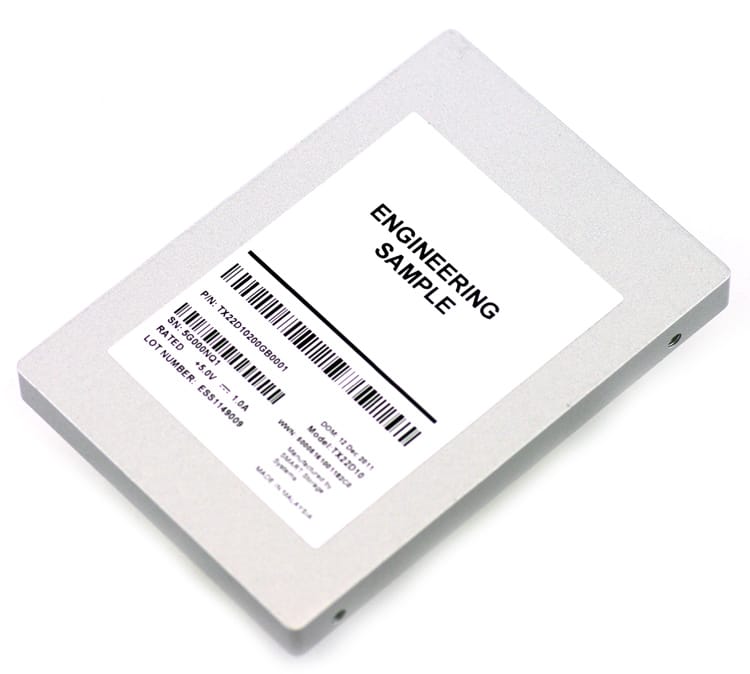
Smart Storage Systems XCeedIOPS2 Specs
- Capacities:
- XceedIOPS2 SATA 1.8"
- 100GB – TX21B10100GB1001
- 200GB – TX21B10200GB1001
- 400GB – TX21B10400GB1001
- XceedIOPS2 SATA 2.5"
- 100GB – TX22D10100GB1001
- 200GB (186GB Usable) – TX22D10200GB1001
- 400GB – TX22D10400GB1001
- XceedIOPS2 SATA 1.8"
- SandForce SF-2582 Controller
- Toshiba 32nm Enterprise MLC NAND
- SATA 6Gb/s interface
- Performance
- Sustained Read – Up to 520 MB/s
- Sustained Write – Up to 500 MB/s
- Up to 60,000 IOPS Random 4K Write
- Access Time <1.0 msec
- Endurance eMLC (Five-year lifetime)
- 100GB – 1.5PBW
- 200GB – 3PBW
- 400GB – 6PBW
- Data Reliability <1 in 1018 bits read
- Error Correction/Error Detection (BCH) – 55 bits for every 512-byte sector
- Data Fail Recovery Recover – up to 1 NAND flash erase block of data
- Power Fail Recovery – EverGuard
- Temperature Monitoring – Performance throttling upon warning/critical temperature
- Encryption AES-256 (FIPS-197 Certified), Security TCG-Enterprise
- Power
- Vcc 3.3 ± 5% 5V ± 5%
- Active (Typ) 1800 mA
- Idle 500 mA
- Advanced Power Management – Power Throttling
- Environmental
- Shock – 200g half-sine, 10msec, 1 shock along each axis, X, Y, Z, in each direction
- Vibration – 200g half-sine, 2msec, 1 shock along each axis, X, Y, Z, in each direction
- Operating Temperature 0 °C to 70 °C (Internal)
- Storage Temperature -40 °C to 90 °C
- Humidity 5% to 95%, non-condensing, relative humidity
- Altitude 24,384 m (80,000 ft)
- Mechanical
- Length 78.5 mm 100.2 mm
- Width 54.0 mm 69.85 mm
- Height 5.0 mm 9.5 mm
- Firmware Version Reviewed – PRO6F4EC
Design and Disassembly
The Smart Storage Systems XceedIOPS2 has a rather basic appearance, with a silver-metallic paint covering a cast metal alloy casing. Our engineering sample has a single product label on the top cover of the case, including the part number, serial number, lot number, as well as basic drive details. The bottom side of the case is entirely blank, showing only screws that let you access the circuit board inside.
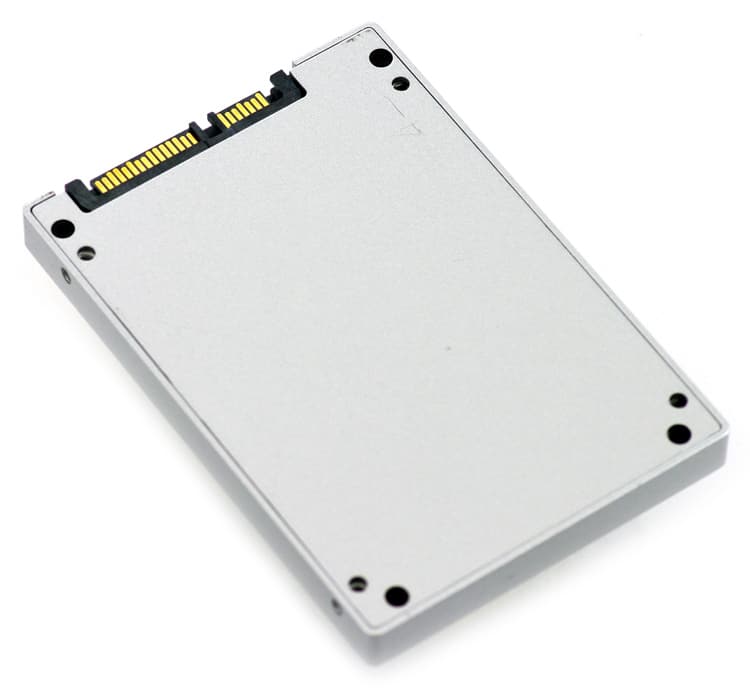
The XceedIOPS2 features a 9.5mm drive z-height, which is standard among consumer and SATA enterprise SSDs. Most of the enterprise-focused SSDs we have reviewed, except for the Intel SSD 710, all offer a 15mm z-height which matches the thickness of 2.5-inch enterprise-grade hard drives. The advantage of using a slimmer design though means that thinner devices such as blade servers or mobile systems that fit an enterprise workload can use this SSD.
The front of the XceedIOPS2 shows off a standard SATA connection, which on this particular SSD is capable of pushing speeds in excess of 500MB/s. The interface is compatible with a wide range of platforms spanning consumer and enterprise systems.

Taking the XceedIOPS2 apart is rather difficult primarily because of the thermal dissipation material Smart used during assembly. For the end-user this is optimal, but for a review it can make things difficult for photography. As you can see below, each piece of NAND and the controller have a dollop of thermal conductive material applied, which acts as a glue when the drive is assembled. To limit damage to the drive for our review purposes, we included one internal shot of the drive for illustration purposes, leaving the thermal equipment intact.
The case measured just under 1.5mm thick and acts as the heatsink for all internal components. Both sides of the circuit board shed heat from the controller and NAND into the upper and lower halves of the case.
Smart Storage Systems uses Toshiba 32nm eMLC NAND inside the XceedIOPS2 SSD. The 200GB capacity uses sixteen NAND pieces in total, with an individual capacity of 16GB. This gives the 200GB model a raw capacity of 256GB and configured with a usable space of 186GB, the SSD has an over-provisioned level of 28%.
The controller used inside the XceedIOPS2 is a SandForce SF-2582, which doesn’t require a additional SDRAM buffer, and has an operating temperature of up to 70C in a commercial environment. The controller also supports AES-256 and TCG Encryption.
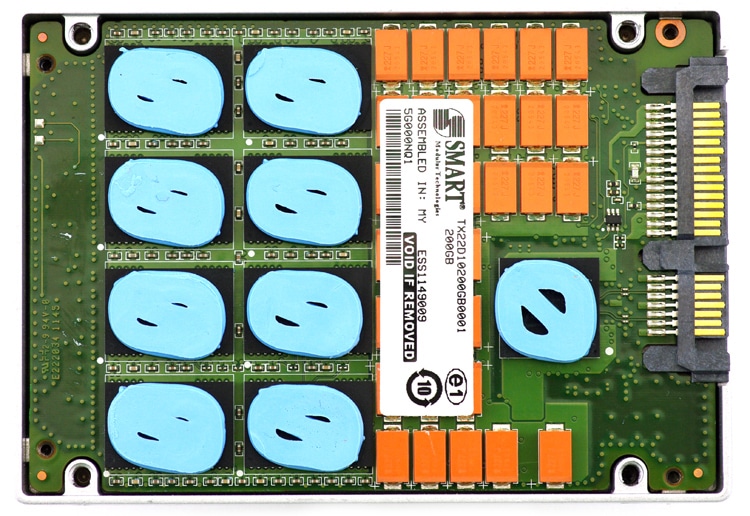
Smart Storage System’s EverGuard Power Failure Recovery setup uses 32 OxiCap Niobium Oxide Capacitors instead of a super-capacitor that is sometimes seen on enterprise SSDs. These are used for power filtration as well as hold-up power in the event incoming power is lost or interrupted, so in-transit data can be flushed to NAND. The 227uF capacitors combined have a total capacitance of 0.007F. Smart doesn’t list the amount of time the power circuitry can keep the controller running, or the charge time, but they are most likely sufficient to prevent data loss in the event of a power disruption. Another key benefit of using this type of capacitor is the thermal envelope of the SSD is raised to 70C during operation, allowing for lower cooling requirements. This is an important feature as many data centers are looking at ways to lower overall cooling costs, as they make up a large portion of the total electric usage.
Enterprise Benchmarks
The Smart Storage Systems XceedIOPS2 uses Toshiba 32nm eMLC NAND, a SandForce SF-2582 controller and a 6.0Gb/s SATA interface; our review unit is 200GB. The comparables used for this review include the following recently tested enterprise SSDs: Micron P300 (100GB, Marvell 9174, Micron 34nm SLC NAND, SATA), Toshiba MKx001GRZB (400GB, Marvell 9032, Toshiba 32nm SLC NAND, SAS), the Samsung SM825 (200GB, Samsung S3C29MAX01-Y330, Samsung 30nm eMLC NAND, SATA), and the Hitachi Ultrastar SSD400M (400GB, Intel EW29AA31AA1 controller, Intel 25nm eMLC NAND, SAS) . All enterprise SSDs are benchmarked on our enterprise testing platform based on a Lenovo ThinkServer RD240. All IOMeter figures are represented as binary figures for MB/s speeds.
Our first test looks at the speed in a sequential write environment with large block transfers. This particular test uses a 2MB transfer size with IOMeter, with 4k sector alignment and measures performance with a queue depth of 4. Smart Storage Systems claims a maximum burst read speed of 520MB/s and a write speed of 500MB/s for their 200GB XceedIOPS. Since this test measures steady-state performance, instead of burst figures for equal comparison across all enterprise drives in a constant workload environment, our measurements will be under the advertised amount since they represent a different longer activity instead of a momentary or burst recording.

In our large-block sequential transfer test we measured a read speed of 531MB/s and a steady-state write speed of 217MB/s. The read speeds came in above Smart’s claim of 520MB/s, but the steady-state write speeds as we had mentioned beforehand came up under the 500MB/s burst rating. In this test the strength of the SandForce SF-2500 processor was clear with the XceedIOPS2 leading the pack in read speed.
Moving to a random access profile, but still maintaining a large block transfer size of 2MB, we start to see how performance varies in a multi-user environment. This test keeps the same queue depth level of 4 that we used in the prior sequential transfer benchmark.

In our large-block random transfer test the XceedIOPS2 maintained a strong read speed of 536MB/s with steady-state write speeds measuring 68MB/s. While the read speeds lead the class of enterprise SSDs, the write speeds came up at the bottom of the pack.
Switching to even smaller random access transfer size of 4K, we get closer to the packet size that might be found in a heavy random access environment such as a server setting with multiple VMs accessing the same array. In the first test we look at expanded 4K read performance and how it scales from a queue depth of 1 to a maximum of 64.
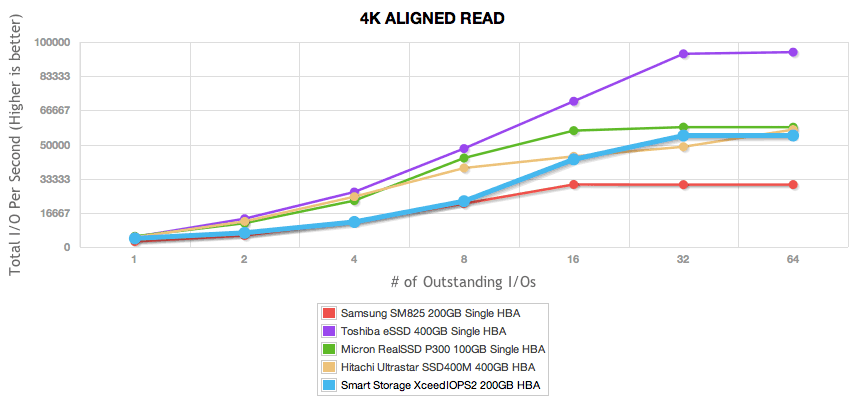
At queue depths below 16, the Smart Storage Systems XceedIOPS2 had no trouble leveraging the strong random 4K read performance of the SandForce controller. Starting off the XceedIOPS2 had a speed of 4,208 IOPS eventually leveling off at 54,386 IOPS. The only drive to surpass it was the SAS-interfaced Toshiba SLC SSD.
Our next test looks at 4K random write performance at a static queue depth of 32 and results are recorded and averaged once the drives have reached steady-state. While IOPS performance is a good metric to measure steady-state performance, another key area of interest is around average and peak latency. Higher peak latency figures can mean certain requests can backed up under heavy continuous access.
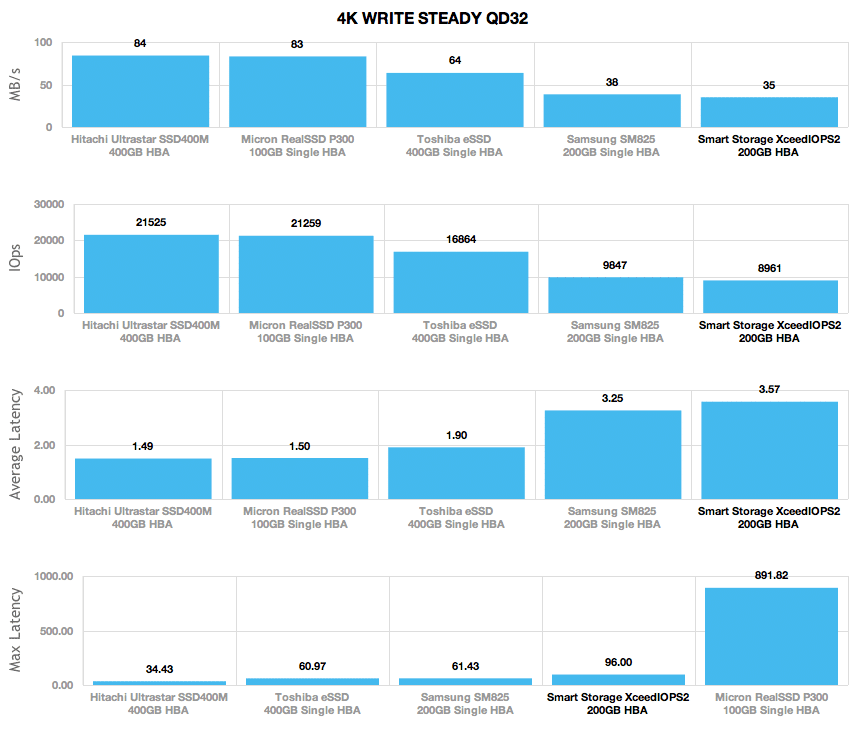
Under a continuous workload, the XceedIOPS2 maintained a steady-state 4K random speed of 8,961 IOPS with an average speed of 35MB/s. Average latency during this test measured 3.57ms with peak latency during our test topping at 96ms.
Our last series of synthetic benchmarks compare both enterprise drives in a series of server mixed-workloads with a static queue depth of 32. Like the synthetic benchmarks at the start of this review, these tests are also measured in steady state. Each of our server profile tests has a strong preference towards read activity, ranging from 67% read with our database profile to 100% read in our web server profile.
The first is our database profile, with a 67% read and 33% write workload mix primarily centered on 8K transfer sizes.
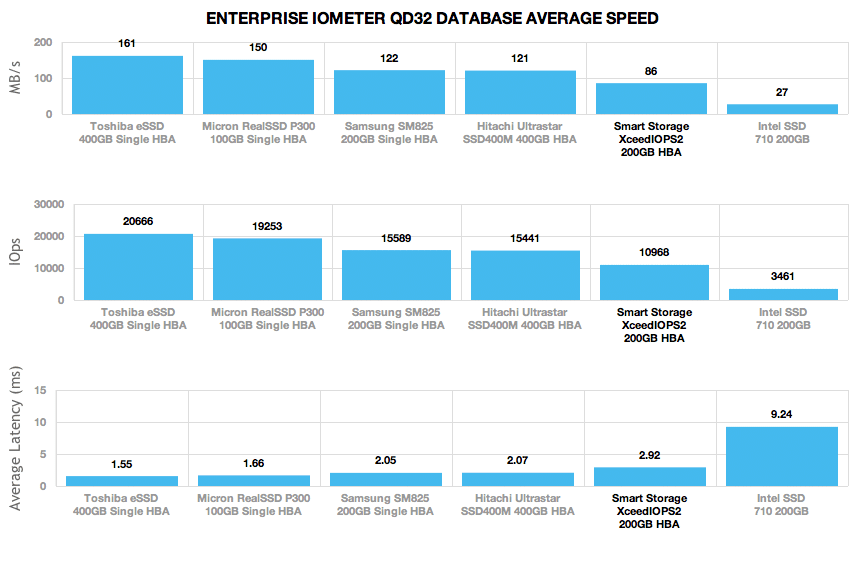
The Smart Storage Systems XceedIOPS2 maintained a steady-state speed of 10,968 IOPS or 86MB/s in our Database profile test. This ranked towards the bottom of the other high-performance eMLC models, but above the eMLC-equipped Intel SSD 710.
The next profile looks at a file server, with 80% read and 20% write workload spread out over multiple transfer sizes ranging from 512-byte to 64KB.
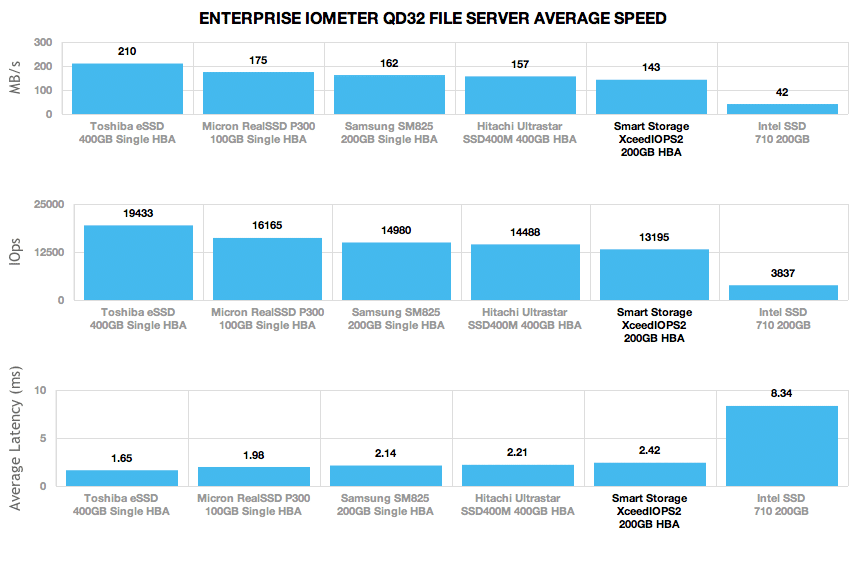
The XceedIOPS2 measured a steady-state speed of 13,195 IOPS a File Server scenario, closely following the eMLC-equipped Samsung SM825 and Hitachi SSD400M, and above the Intel SSD 710.
Our web server profile is read-only with a spread of transfer sizes from 512-byte to 512KB.
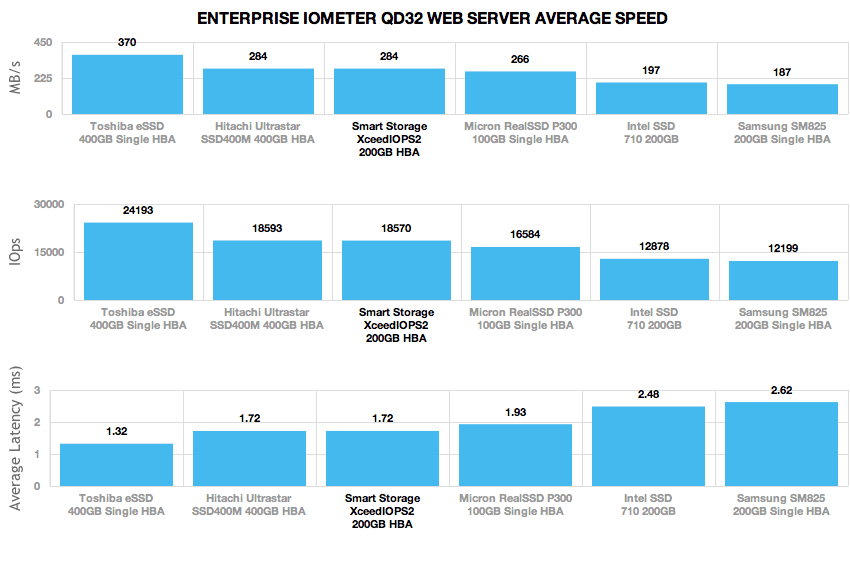
In a read-only environment, the Smart XceedIOPS2 was able to stretch its legs a bit and move up towards the top of the enterprise SSD pack. In this workload the XceedIOPS2 maintained a speed of 18,570 IOPS or 284MB/s.
The last profile looks at a workstation, with a 20% write and 80% read mixture using 8K transfers.
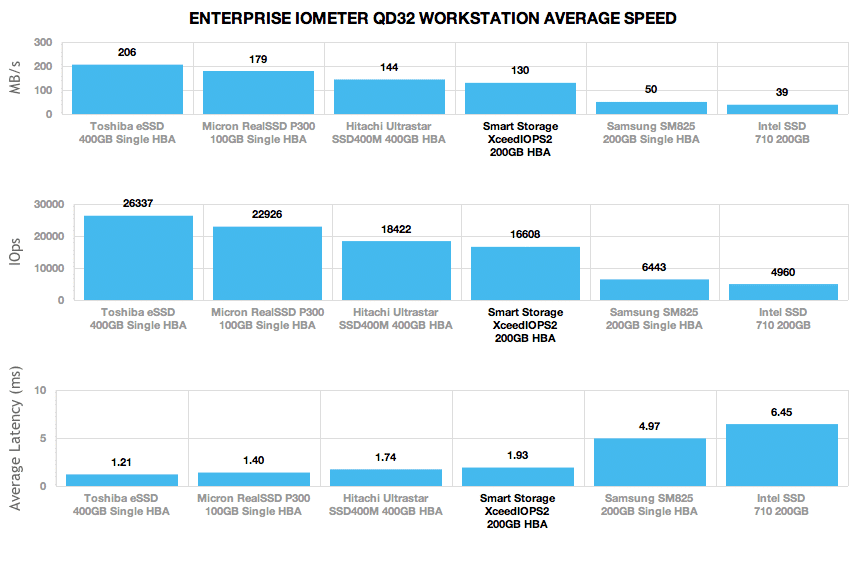
In a workstation environment the XceedIOPS2 ranked 2nd among the eMLC enterprise-grade SSDs we have reviewed, coming in below the Ultrastar SSD400M with speed of 16,608 IOPS or 130MB/s.
Enterprise Power Consumption
When it comes to choosing drives for the datacenter or other densely-packed storage environment, performance isn’t the only metric companies are interested in when looking at SSDs or hard drives. Power consumption can be a huge deal in certain cases, so it makes sense that you would want to know how a drive would perform under a constant workload.
In the Enterprise Power section of this review, we look at each drive under the same conditions we used to test the read and write speeds in earlier. This includes sequential and random 2MB transfers with a queue depth of 4 and small random 4K read and write transfers at a queue depth of 32. As with our previous tests we are measuring all figures in a steady-state to put the drive into its most power-hungry conditions.
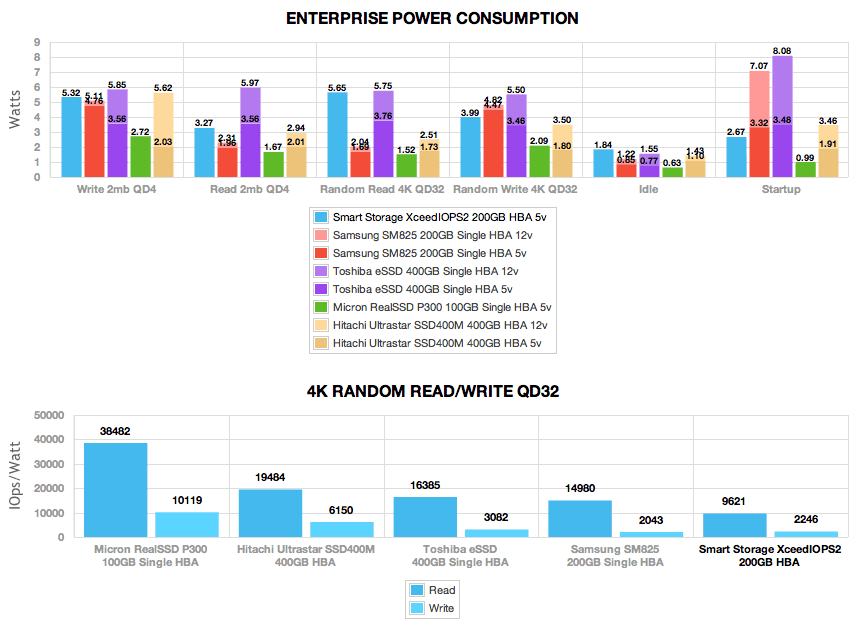
Under all conditions except start-up, the Smart Storage Systems XceedIOPS2 used 5.65 watts or less. The most power hungry activity for the XceedIOPS2 was random QD32 4K read, using 5.65 watts averaged over the duration of the test. Second was sequential 2MB QD4 write, third was random QD32 4K write followed by 2MB QD4 read coming in fourth. During heavy-write and random 4K read activity the Smart Storage Systems XceedIOPS2 used just under the amount of power the SAS 6.0Gb/s Toshiba MKx001GRZB required, falling down in other areas with close parity to the Hitachi Ultrastar SSD400M.
A large push for an eMLC SSD in a datacenter environment is around cost per GB and IOPS/Watt. We calculated a figure of 9,621 IOPS/watt in pure random 4K read at a queue depth of 32, dropping to 2,246 IOPS/watt if you instead look at steady 4K random write. This compared to 38,481 IOPS/watt read or 10,119 IOPS/watt write on the SLC Micron P300 or 16,385 IOPS/watt read, 3,082 IOPS/watt write on the SLC Toshiba MKx001GRZB, 14,980 IOPS/watt read, 2,043 IOPS/watt write on the eMLC Samsung SM825, or 19,484 IOPS/watt read, 6,150 IOPS/watt write on the eMLC Hitachi Ultrastar SSD400M. It really comes down to the needs of the business, finding the best blend of power to performance (or just straight performance) that factors in when buying the SSD or hard drive.
Conclusion
While Smart Storage Systems (Smart Modular) may not be a household name, in the enterprise they’re known for quality and innovation. The XceedIOPS2 fills an interesting spot in the enterprise SSD market, offering a SATA interface with SandForce SF-2500 performance and eMLC NAND that can support up to seven drive writes per day. The XceedIOPS2 posted the best 2MB sequential and random read scores we’ve seen out of any SAS or SATA enterprise SSD, more or less taking all the interface could give. Such read performance certainly bodes well for applications like web and file serving where rapid reads are required. It also offered the strongest random 4K read performance at lower queue depths, posting speeds 2-4x higher than any other comparable SSD.
On the write-performance side of the equation, the drive finished near the lower half of the pack in 2MB and 4K testing, which shouldn’t come as a surprise as the SF-2582 isn’t known for top performance in that area with incompressible data. In the enterprise usage profiles, the drive does well where it should, falling a little behind in the database and workstation profiles, but delivering very competitive scores in the file server and web server profiles, where it’s only beaten obviously by the SLC SAS Toshiba eSSD. Compared to the Hitachi Ultrastar SSD400M and Samsung SM825 which is directly competes against, the XceedIOPS2 offers good performance, and against the Intel SSD 710 it offers a substantial increase.
With performance better than or at least on par for a drive configuration of this type, Smart is able to show off their engineering strengths in other areas as well. The XceedIOPS2 offers excellent thermal dissipation and a higher operating thermal envelope, which leads to lower cooling expense. There’s also the obvious benefit of the endurance they’re able to get out of the eMLC NAND, making the drive an excellent operator in settings with both read and write activity, something not all eMLC/MLC drives are capable of. For businesses at different product offerings, the XceedIOPS2 is a very good choice, with Tier 1 enterprise certifications and very compelling performance traits.
Pros
- Excellent large-block read speeds
- Very strong low queue-depth random 4K read speeds
- Great thermal design with a high rated operating temperature
- Good write performance compared to other eMLC enterprise-grade SSDs
Cons
- Slightly higher than average power demands
- Weaker write-intensive performance than some high-performance eMLC offerings
Bottom Line
Strictly from a performance perspective, the XceedIOPS2 has definite strengths, especially with workloads that offer some level of compressibility to pick up speed on, and it’s generally strong throughout when it comes to reads. Overall, when you factor in the endurance of seven daily drive fills and the cost savings of eMLC NAND, the value proposition starts to get pretty strong for Smart.




 Amazon
Amazon